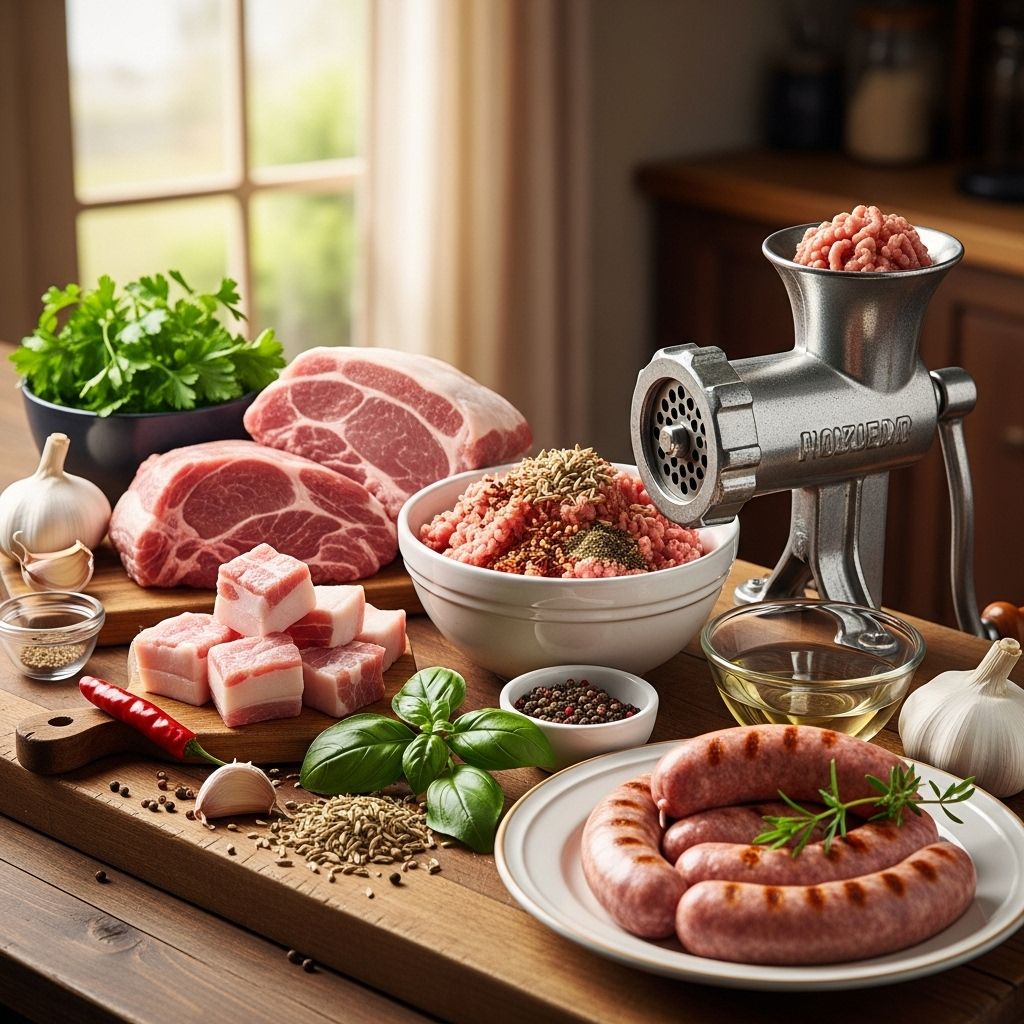Homemade Italian Sausage Recipe: Complete Step-By-Step Guide
Master the art of crafting delicious Italian sausage from scratch with simple ingredients

Image: HearthJunction Design Team
Authentic Homemade Italian Sausage Recipe: A Complete Guide
Creating your own Italian sausage at home is a rewarding culinary adventure that connects you with centuries of tradition. With just a few quality ingredients and some basic techniques, you can craft sausage that surpasses anything found in stores. This comprehensive guide will walk you through every step of the process, from selecting the right cuts of meat to achieving the perfect blend of spices that define authentic Italian sausage.
Why Make Italian Sausage at Home?
Store-bought Italian sausage often contains preservatives, fillers, and excessive fat. By making sausage at home, you control every ingredient that goes into your mixture. You can adjust the flavor profile to your preference—making it spicier, more aromatic with fennel, or even creating a sweeter variant. Additionally, homemade sausage allows you to select high-quality, ethically sourced meat and customize the fat content.
The tradition of sausage-making dates back thousands of years as a method of preserving meat. Italian sausage specifically has regional variations throughout Italy, with northern regions often featuring more garlic and southern regions incorporating more red pepper. By making your own, you’re participating in this rich culinary heritage while creating something truly special for your table.
Essential Ingredients for Authentic Italian Sausage
The beauty of Italian sausage lies in its relatively simple ingredient list. However, each component plays a crucial role in developing the characteristic flavor. Here’s what you’ll need to create authentic homemade Italian sausage:
The Meat Base
The foundation of great Italian sausage is the meat selection. For traditional results, you’ll need:
- 3 pounds pork shoulder – Sometimes called Boston butt, this cut offers the ideal balance of lean meat and fat. The natural marbling ensures juicy, flavorful sausage.
- Fat ratio – Aim for a final fat content of approximately 25-30% for the juiciest results. You can adjust this by trimming or adding pork fat as needed.
The Signature Spice Blend
The aromatic spice mixture is what transforms ground pork into authentic Italian sausage. Here’s what you’ll need:
- 2 tablespoons whole fennel seeds, toasted – The distinctive anise-like flavor that defines Italian sausage
- 1 teaspoon anise seed – Enhances the licorice notes and complements the fennel
- 4 cloves garlic – Provides essential aromatic depth
- 1 ounce kosher salt, divided – Critical for both flavor and preservation
- 2 teaspoons freshly ground black pepper – Adds pleasant heat and complexity
- 2 teaspoons red pepper flakes – Adjustable depending on desired spice level
- 1/2 teaspoon dried oregano – Adds an herbal Mediterranean note
- 2 tablespoons paprika – Contributes color and mild sweetness
Optional Ingredients
While not traditional in all Italian sausage varieties, these ingredients can be added based on regional preferences or personal taste:
- 1-2 tablespoons brown sugar – For sweet Italian sausage variants
- 1 teaspoon dried basil – Adds an herbaceous quality
- 1/4 cup dry red wine – Contributes depth and moisture
- 1 teaspoon ground coriander – For additional aromatic complexity
Essential Equipment for Sausage Making
While you can make the sausage mixture with basic kitchen tools, having the right equipment makes the process more efficient:
- Meat grinder – For optimal texture control (a food processor can work in a pinch)
- Large mixing bowl – Preferably chilled for maintaining cold temperatures
- Sharp knife and cutting board – For preparing the meat
- Spice grinder or mortar and pestle – For toasting and crushing spices
- Kitchen scale – For precise measurements
- Sausage stuffer and casings – Optional, if making links rather than bulk sausage
- Meat thermometer – For cooking to the proper temperature
Step-by-Step Preparation Guide
Follow these detailed steps to create perfect homemade Italian sausage every time:
Preparing the Meat
- Chill all equipment: Place your grinding equipment, mixing bowls, and even the metal parts of your grinder in the freezer for 30 minutes before beginning. Cold equipment prevents fat from smearing during processing.
- Prepare the pork: Cut the pork shoulder into 1-inch cubes, removing any tough connective tissue. Leave the fat intact. Spread the meat on a baking sheet and place in the freezer for 20-30 minutes until firm but not frozen solid. This partial freezing makes grinding easier and maintains the ideal texture.
Creating the Spice Mixture
- Toast the fennel seeds: Heat a dry skillet over medium heat. Add the fennel seeds and toast for 1-2 minutes until fragrant, shaking the pan frequently to prevent burning.
- Prepare the garlic: Mince the garlic cloves finely or use a garlic press.
- Combine the spices: In a small bowl, mix the toasted fennel seeds, anise seed, minced garlic, half of the kosher salt, black pepper, red pepper flakes, oregano, and paprika. Set aside.
Grinding and Mixing
- Grind the meat: Pass the chilled pork cubes through the grinder using a medium die (about 6mm). If you don’t have a grinder, you can pulse the meat in a food processor in small batches, being careful not to over-process.
- Add the spices: Transfer the ground meat to a large chilled mixing bowl. Sprinkle the spice mixture and remaining salt over the meat. With clean hands, gently mix until the spices are evenly distributed. Avoid overworking the meat, which can result in a tough texture.
- Test the flavor: Take a small portion of the mixture and cook it in a skillet to test the flavor and seasoning. Adjust spices as needed.
Final Preparation
- For bulk sausage: Package the sausage mixture in portions suitable for your needs. Wrap tightly in plastic wrap or vacuum seal.
- For links: If using casings, prepare them according to package directions. Use a sausage stuffer to fill the casings, twisting at regular intervals to create links of your desired length.
- Rest the sausage: For the best flavor development, let the sausage rest in the refrigerator for at least 24 hours before cooking. This allows the flavors to meld and fully permeate the meat.
Cooking Methods and Serving Suggestions
Italian sausage versatility makes it perfect for countless dishes. Here are the best methods for cooking your homemade creation:
Basic Cooking Techniques
- Pan-frying: Heat a skillet over medium heat with a small amount of oil. Cook sausage patties or links for 4-5 minutes per side until browned and internal temperature reaches 160°F (71°C).
- Grilling: Preheat grill to medium heat. Grill sausage links for 15-20 minutes, turning occasionally until cooked through.
- Baking: Preheat oven to 375°F (190°C). Place sausages on a parchment-lined baking sheet and bake for 25-30 minutes until golden and cooked through.
- Braising: Brown sausages in a pan, then add liquid (wine, broth, or tomato sauce) and simmer covered for 10-15 minutes until cooked through.
Classic Italian Dishes Using Homemade Sausage
Put your homemade sausage to use in these traditional Italian preparations:
- Sausage and Peppers: Sauté bell peppers and onions until soft, then add sliced cooked sausage and continue cooking until everything is caramelized.
- Pasta with Sausage Ragù: Brown crumbled sausage, add garlic, crushed tomatoes, and herbs, then simmer until thickened. Serve over your favorite pasta.
- Sausage and Broccoli Rabe: Sauté blanched broccoli rabe with garlic and red pepper flakes, then add sliced cooked sausage and toss with orecchiette pasta.
- Sausage-Stuffed Mushrooms: Fill mushroom caps with a mixture of crumbled cooked sausage, breadcrumbs, cheese, and herbs, then bake until golden.
- Italian Wedding Soup: Form small meatballs from the sausage mixture and simmer in chicken broth with escarole or spinach.
Storage and Preservation
Proper storage ensures your homemade sausage stays fresh and delicious:
- Refrigeration: Fresh sausage will keep in the refrigerator for 2-3 days.
- Freezing: Wrap individual portions tightly in plastic wrap, then place in freezer bags or vacuum seal. Frozen sausage will maintain quality for up to 3 months.
- Thawing: Always thaw frozen sausage in the refrigerator, never at room temperature.
- Curing: Traditional preservation methods involve curing and air-drying, but this requires specific equipment and expertise to ensure safety.
Variations on Classic Italian Sausage
Once you’ve mastered the basic recipe, consider these regional and flavor variations:
Regional Italian Variations
- Sicilian-Style: Increase the red pepper flakes and add a pinch of cinnamon and orange zest.
- Calabrian: Add more hot pepper and incorporate some Calabrian chili paste for authentic regional heat.
- Northern Italian: Increase the garlic and add some grated nutmeg and white wine.
Sweet vs. Hot Italian Sausage
The primary difference between sweet and hot Italian sausage is the amount of red pepper flakes:
- For Sweet Italian Sausage: Omit or significantly reduce the red pepper flakes and add 1-2 tablespoons brown sugar.
- For Hot Italian Sausage: Increase red pepper flakes to 1 tablespoon or more, depending on your heat preference.
Alternative Meat Options
While traditional Italian sausage uses pork, you can experiment with alternatives:
- Chicken or Turkey: Use ground thigh meat and add 10-15% pork fat for juiciness.
- Beef: Use chuck with added beef fat for a richer flavor profile.
- Veal and Pork Blend: A 50/50 mix creates a delicate yet flavorful sausage.
Troubleshooting Common Issues
Even experienced sausage makers encounter challenges. Here are solutions to common problems:
- Dry sausage: Increase fat content or add a small amount of cold water to the mixture.
- Crumbly texture: The meat may have warmed too much during processing. Keep everything very cold and work quickly.
- Bland flavor: Increase salt and spices, remembering that flavors will develop and intensify after resting.
- Too salty: Mix with additional unseasoned ground pork to dilute the saltiness.
- Casings bursting: Don’t overfill casings and prick them with a needle before cooking to release steam.
Frequently Asked Questions (FAQs)
Q: Can I make Italian sausage without a meat grinder?
A: Yes, you can purchase pre-ground pork and mix in the spices by hand, or use a food processor to pulse pork chunks in small batches. Be careful not to overprocess, which can create a paste-like texture.
Q: How can I tell if my homemade sausage has gone bad?
A: Fresh sausage should have a clean, meaty smell. If it develops a sour or off odor, slimy texture, or grayish color, discard it immediately. Always cook sausage to an internal temperature of 160°F (71°C) for safety.
Q: Can I reduce the salt in this recipe?
A: Salt serves both as flavor and preservation in sausage. You can reduce it slightly, but eliminating it completely will affect both taste and shelf life. If serving to someone on a salt-restricted diet, consider making patties rather than links, which allows you to reduce salt further.
Q: What’s the difference between Italian sausage and breakfast sausage?
A: Italian sausage is characterized by fennel and anise seeds, while American breakfast sausage typically features sage and sometimes maple flavors. The spice profiles are quite different, with Italian sausage often being more aromatic.
Q: Can I make this recipe ahead for a party?
A: Absolutely! In fact, the flavor improves after 24-48 hours of resting in the refrigerator. You can make the sausage up to 2-3 days ahead if refrigerated promptly, or freeze for longer storage.
Creating homemade Italian sausage connects you with centuries of culinary tradition while allowing you to customize the flavors to your preference. With quality ingredients, attention to technique, and a little patience, you’ll master the art of sausage-making and elevate countless dishes with your handcrafted creation.
References
- https://www.allrecipes.com/recipe/265538/homemade-italian-sausage/
- https://www.allrecipes.com/recipe/16539/italian-style-sausage/
- https://www.allrecipes.com/recipe/216319/homemade-sweet-italian-sausage-mild-or-hot/
- https://www.allrecipes.com/recipe/35989/hot-italian-sausage/
- https://www.allrecipes.com/recipe/16359/breakfast-sausage/
Read full bio of Anjali Sayee












